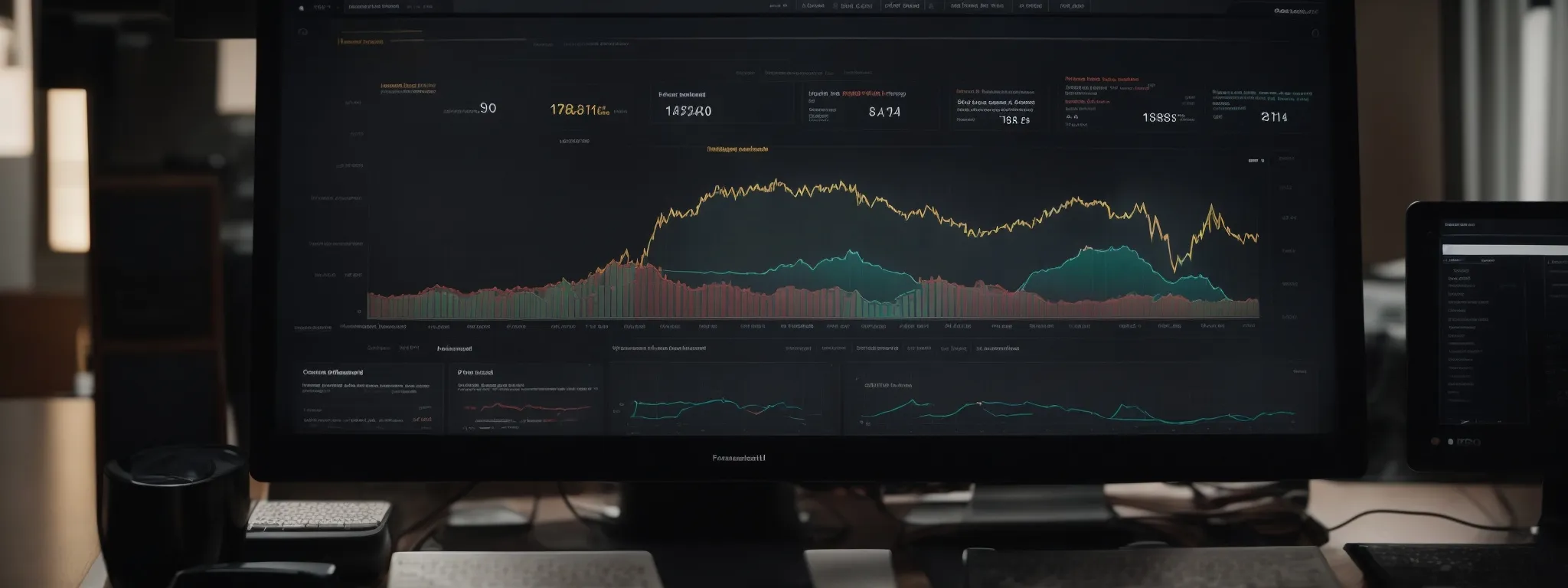Expert Insights: Conversion Rate Optimization
Maximizing Your Website’s Potential: Expert Insights on Conversion Rate Optimization In the fast-paced realm of digital marketing, conversion rate optimization (CRO) emerges as the lynchpin of successful […]
Maximizing Your Website’s Potential: Expert Insights on Conversion Rate Optimization
In the fast-paced realm of digital marketing, conversion rate optimization (CRO) emerges as the lynchpin of successful online strategies.
By fine-tuning websites to meet user expectations and streamline the path to conversion, businesses can significantly amplify their growth potential.
Conversion rate experts employ a myriad of techniques—ranging from meticulous data analysis to user experience enhancement—to ensure that each website visitor is more likely to become a valuable customer.
These practices demand a methodical approach, marrying creativity with analytical prowess to evolve web properties into high-performance conversion engines.
Keep reading to unlock a treasure trove of expert insights that will transform your website into a conversion powerhouse.
Key Takeaways
- Conversion Rate Optimization Is Essential for Transforming Website Visitors Into Loyal Customers
- Personalization and Segmentation Are Effective CRO Strategies That Cater to User Preferences and Enhance Engagement
- Web Analytics Tools Are Indispensable in Crafting Data-Driven CRO Strategies and Understanding User Behavior
- Incorporating a/B and Multivariate Testing Allows for Precise Refinements to Website Elements Based on User Interaction Data
- Establishing a Culture of Continuous Improvement and Feedback Is Crucial for Long-Term Success in CRO
Understanding Conversion Rate Optimization Essentials

In the realm of digital marketing, the quest for an optimized website capable of converting a casual visitor into a committed customer is relentless.
At the core of this endeavor sits Conversion Rate Optimization (CRO), a meticulous process designed to enhance website performance by spotlighting the significance of conversion rates as a pivotal metric for success.
The journey to CRO mastery begins with a firm grasp of what conversion rate entails and its profound impact on a company’s online presence.
Alongside this fundamental understanding, pinpointing precise website objectives and diligently monitoring key metrics establish the groundwork for a data-driven strategy that can transform user interactions into tangible business growth.
Defining Conversion Rate and Its Significance
Conversion rate emerges as a critical gauge in digital marketing, revealing the frequency at which users perform the desired action on a website. This key performance indicator is not just a mere statistic; it is reflective of the effectiveness with which a company’s digital presence resonates with its target audience, influencing their decision-making process and boosting the likelihood of successful transactions.
The import of conversion rates extends beyond quantifying success; it serves as a beacon to guide digital marketing solutions towards a more customer-centric approach. Enterprises strive to augment these rates, for such improvements are synonymous with enhanced user experience, elevated brand loyalty, and, crucially, increased revenue – the ultimate ambition of any profitable venture.
Identifying Your Website Goals
Embarking on conversion rate optimization demands clarity on an entity’s digital aspirations. Before diving deep into metrics and methodologies, it is paramount for a firm to articulate precise, actionable goals for their website—whether it be increasing newsletter sign-ups, elevating product sales, or amplifying event registrations—effectively mapping out the path to optimization and tailored customer journeys.
With these tailored objectives in hand, a company positions itself strategically to orchestrate all optimization efforts towards fulfilling its unique business goals. It becomes a targeted endeavor: every alteration to a landing page, every tweak in the user experience is now a step towards concertedly bolstering those conversion rates, channeling visitors along a meticulously curated path from curiosity to conversion.
Key Metrics to Track for CRO
Thorough scrutiny into visitor behavior and conversion patterns is crucial for a sound CRO strategy. Tracking metrics such as the bounce rate, which highlights the percentage of visitors who leave the site after viewing only one page, or average session duration, providing insights into the amount of time users spend before taking action, equips digital marketing specialists with actionable data.
Analyzing conversion paths and funnels is equally indispensable, as it delves into the steps a user takes before completing a goal. This includes evaluating the effectiveness of call-to-action elements, assessing Form Completion Rates, and examining the flow of user navigation to optimize each stage of the journey for potential customers.
Crafting a User-Friendly Website for Higher Conversions

An expertly designed website serves not only as a brand’s digital storefront but also as a pivotal element in its conversion rate optimization strategy.
In today’s fast-paced digital landscape, creating a user-friendly website transcends aesthetic appeal; it demands a seamless, intuitive interface that promptly guides users towards completing their objectives.
Simplifying navigation emerges as a fundamental step in enriching user experience, a compass pointing users efficiently through their online journey.
Moreover, embracing Responsive Design acknowledges the diversity of devices used by potential customers, ensuring functionality and visual coherence across a multitude of screens.
Another cornerstone in optimizing for conversions is the unwavering focus on reducing website loading time, fostering prompt access to content and diminishing the likelihood of visitor drop-off.
Collectively, these enhancements are instrumental in transforming a passive visitor into an engaged, active participant in the online narrative a company seeks to weave.
Simplifying Navigation to Enhance User Experience
To elevate the user experience, simplicity in navigation is paramount. Visitors to a website should find a clear, straightforward path to the information or products they seek, minimizing confusion and the potential for frustration.
A pristine, well-structured navigation setup acts as a silent ambassador of user-friendliness: providing a frictionless browsing experience that aids in retaining visitors’ attention and guiding them effortlessly towards conversion:
- Implementing an intuitive menu hierarchy that mirrors the priorities and relationships of the content.
- Streamlining navigation bars to include only the most essential items, reducing cognitive load and decision time.
- Ensuring that calls-to-action are prominently displayed, straightforward, and indicative of their outcome, facilitating smooth progress through the conversion funnel.
These navigational refinements are instrumental in constructing an accommodating environment that not only encourages a visitor’s retention but also subtly propels them towards taking actionable steps, whether that’s a product purchase, service enrollment, or content subscription.
Employing Responsive Design for Mobile Users
Recognizing the increasing prevalence of mobile device usage for internet access, responsive design is not merely an option but a necessity for digital marketers aiming to secure high conversion rates. Employing responsive design ensures that a user’s experience is consistently positive, independent of the device they utilize to visit a company’s website.
This adaptive approach to web design profoundly impacts a user’s interaction, leading to more lengthy and engaging website visits: a stepping stone to elevated conversion rates for the mobile audience, who might otherwise be discouraged by a less accommodating webpage layout.
| Aspect | Importance | Impact on Conversion |
|---|---|---|
| Uniform User Experience | Essential for user satisfaction across devices | Increases engagement and potential for conversion |
| Adaptability | Facilitates seamless interaction regardless of screen size | Promotes a positive image and usability, enhancing conversion likelihood |
| Loading Speed | Crucial to retain mobile user’s attention | Optimized loading times can significantly reduce bounce rates |
Reducing Website Loading Time
A swift website is the bedrock of customer satisfaction and a linchpin in optimizing conversion rates. Experts in the digital marketing domain understand that even a one-second delay in page response can precipitously plummet the probability of conversion, making speed an irrefutable priority for businesses aiming to excel online.
In the pursuit of rapid website performance, fine-tuning the technical aspects such as optimizing images, leveraging browser caching, and reducing server response time becomes imperatively central. These actions are pivotal in decreasing loading times, thus cultivating a robust user experience that accelerates the journey from initial click to a fruitful conversion.
Strategic Use of Calls-to-Action to Boost Engagement

As digital marketers hone the art of conversion rate optimization, the power of Calls-to-Action (CTAs) becomes abundantly clear.
As direct prompts guiding users to take desired steps, CTAs are the linchpin of the conversion mechanism, propelling audience engagement forward.
Crafting CTAs that command attention and evoke action is no mere happenstance; it involves deliberate placement, thoughtful design, and persuasive copy.
Employing data analytics and A/B testing refines the effectiveness of these vital elements, ensuring that every CTA strikes the perfect chord with its intended audience.
This critical focus on engagement forms the basis of a robust CRO strategy that aims to translate user interest into definitive action.
Placement and Design of Effective CTAs
The strategic placement and design of Calls-to-Action (CTAs) are of paramount importance in the realm of conversion rate optimization. An effective CTA should be positioned where it is likely to attract the user’s attention, be it below a compelling piece of content or beside an engaging visual element that relates to the offer:
- CTAs placed above the fold typically garner immediate visibility, prompting swift action from the user.
- Design elements, such as contrasting colors and bold text, draw the eye and make the CTA stand out on the page.
- The shape and size of the button also play a role; it should be large enough to notice, yet harmonious with the overall website design.
In addition to its placement, the design of a CTA must also be tuned to embody clarity and conciseness, compelling users to act without hesitation. The choice of words should be decisive, infused with a sense of urgency that nudges the user from contemplation to action, effectively transforming a passive visitor into an active participant in the conversion process.
A/B Testing CTA Copy for Optimal Results
A/B testing stands as a cornerstone of conversion optimization, wielding the power to meticulously refine the messaging within calls-to-action (CTAs). By deploying this experimental approach, marketers harness the ability to compare different CTA texts, revealing which variant catalyzes the most clicks and conversions: a process that can lead to potent improvements in the user’s journey towards becoming a lead or customer.
It’s the granularity of A/B testing that offers concrete insights into the nuances of user preference and behavior. Marketers, equipped with data-driven results, gain invaluable clues on crafting CTAs that resonate more meaningfully with the target audience, thus optimizing the overall conversion landscape:
- Identifying variations of CTA copy that accelerate user engagement.
- Analyzing click-through and conversion data to determine winning strategies.
- Implementing the most persuasive CTA text across the website to amplify conversion rates.
Analyzing CTA Performance Data
In the meticulous world of digital conversion optimization, analyzing CTA performance data is a pivotal step toward enhancing user engagement and bolstering conversion rates. This analytical approach involves rigorous examination of click-through rates and user interaction patterns with the CTA, transforming raw data into a strategic asset that fine-tunes the effectiveness of a conversion-centric website.
Marketing experts recognize the value of CTA performance analysis as it provides a clear indication of which parts of the website are effectively communicating with the audience and instigating the desired actions. Leveraging this data, companies can make informed decisions to tweak and optimize their CTAs, ensuring each call-to-action aligns perfectly with the company’s conversion goals and resonates with the target user base.
Leveraging Social Proof to Increase Trust and Conversions

In the intricate tapestry of conversion rate optimization, incorporating elements of social proof stands as a testament to a brand’s credibility and efficacy, invariably influencing consumer trust and subsequent conversion rates.
Social proof works under the psychological premise that individuals’ actions are impacted by the actions and opinions of others, thus, insightful digital marketers use this to their advantage.
By seamlessly integrating customer testimonials and reviews, displaying badges of trust and certifications, and showcasing authentic user-generated content, websites can subtly affirm their value proposition and instill confidence in potential customers.
These elements not only serve as emblems of the website’s authority and reliability but also resonate with the prospects on a personal level – encouraging them to move from consideration to action.
Integrating Customer Testimonials and Reviews
Integrating customer testimonials and reviews cultivates a sense of authenticity and trust on a website, which can be a game-changer for converting visitors into customers. By showcasing real feedback from satisfied clients, a website not only validates the quality of its offerings but also connects with new visitors on a deeper, more trustworthy level.
Building a repository of genuine customer experiences offers a narrative for prospective buyers, illustrating the company’s dedication to fulfilling customer needs and delivering exceptional value. Utilizing these testimonials strategically across a website can decisively tilt the balance, transforming user skepticism into confidence that leads to conversion:
- Feature success stories on key conversion pages, such as product details or checkout.
- Curate a blend of video and written testimonies to cater to different user preferences.
- Display ratings and reviews prominently to highlight social endorsement.
Displaying Trust Badges and Certifications
In a digital environment where trust translates to clicks and conversions, displaying trust badges and certifications contributes substantially to a website’s credibility. These visual endorsements, such as security seals or accreditation symbols, confirm that a site is recognized by respectable institutions, bolstering the confidence of website visitors and catalyzing their decision to engage with the brand.
The strategic placement of these trust indicators can effectively act as a catalyst, enhancing customer confidence at critical junctures in the online experience, such as during the checkout process or on landing pages. This visible commitment to authenticity and transparency communicates reliability, thereby encoding an additional layer of trust that can directly heighten conversion rates.
Showcasing User-Generated Content
Showcasing user-generated content on a website serves as a powerful endorsement of a brand’s reputation. Through authentic images, videos, and stories created by customers, potential buyers perceive a relatable and trustworthy narrative that goes beyond what traditional marketing efforts can convey.
This practice of sharing user content effectively solidifies a community around the brand, displaying a transparent and customer-valued business ethos. Highlighting this genuine engagement demonstrates to site visitors that their voices are heard and appreciated, significantly fortifying trust and encouraging conversions:
- Utilize social media posts from customers to enrich product pages with real-world applications.
- Incorporate user-generated reviews and ratings for a transparent display of customer satisfaction.
- Create a dedicated section showcasing customer stories and experiences to reinforce brand loyalty.
Maximizing Landing Page Impact for Conversion Uplift

The digital landscape is an ever-evolving arena where the efficacy of a company’s online presence can be measured by its ability to capture and hold the attention of website visitors.
Focused efforts on landing page optimization form the backbone of a robust conversion rate optimization strategy, emphasizing the need to design a point of entry that is not only visually appealing but strategically structured to guide users toward desired actions.
In this context, understanding the elements of a high-converting landing page, recognizing the paramount importance of above-the-fold content, and embracing the iterative process of A/B testing landing page designs are pivotal factors in elevating website performance and achieving significant conversion uplift.
Elements of a High-Converting Landing Page
Designing high-converting landing pages is a sophisticated art that hinges on a harmonious mix of persuasive elements. A potent headline that captures attention, coupled with a value proposition clearly articulating the benefit of the offering, sets the stage for an effective landing page setup.
Compelling visual content and a strategically placed call-to-action (CTA) work in concert to guide visitors through the decision-making journey. Succinct, benefit-driven copy along with social proof further reinforce the message, encouraging the visitor to take the leap from prospect to customer:
| Element | Function | Significance |
|---|---|---|
| Headline | Captures attention and interest | Sets the initial tone and relevance for the visitor |
| Value Proposition | Articulates benefits clearly | Highlights the unique advantage and purpose |
| Visual Content | Enhances appeal and comprehension | Supports copy and keeps the visitor engaged |
| Call-To-Action | Prompts decision and action | Crucial for driving conversions |
| Social Proof | Builds trust and credibility | Leverages communal endorsement to influence user behaviour |
Importance of Above-the-Fold Content
The quintessence of above-the-fold content lies in its capacity to make a Compelling First Impression. This prime digital real estate, visible without scrolling, bears the critical mission of instantly communicating the essence and value of a website to its newly arrived guests.
Engaging the visitor’s interest from the outset, above-the-fold content is the keystone to website optimization, strategically crafted to anchor attention and usher users toward the desired call-to-action with remarkable efficacy.
A/B Testing Various Landing Page Designs
Deploying A/B testing for landing page designs empowers digital marketers to refine user experience through empirical evidence. It allows them to compare two versions of a page side by side to determine which one performs better in terms of engagement and conversion rate.
This methodical split-testing approach carves a path to enhanced performance by spotlighting the landing page elements most effective at driving user actions. Focusing on these optimization insights, companies can iteratively improve their online conversion funnel to meet specific business objectives.
Enhancing Forms to Minimize Abandonment Rates

In a digital ecosystem where the attention span of users is increasingly fleeting, streamlining the process of data entry is intrinsic to maintaining visitor interest and facilitating the completion of online actions.
A focus on enhancing forms on a website can significantly diminish abandonment rates and elevate completion metrics.
This involves simplifying form fields to reduce user effort, clearly stating privacy policies to build trust, and incorporating inline validation for instantaneously guiding users through a seamless form submission process.
Delving into these strategic implementations can effectively fine-tune the user’s experience, leading to improved conversion rates that resonate with the overall objectives of the website.
Simplifying Form Fields to Increase Completions
In the intricate dance of conversion optimization, the simplification of form fields stands out as a masterful strategic move. By paring down to the essential information needed from users, the efficiency of form completion skyrockets, paving the way for a rise in successful conversions and a decrease in user frustration.
Experts in the digital marketing space consistently find that a concise form not only respects the user’s time but also streamlines the path to conversion. This honed focus on user completion echoes throughout the site’s analytics as more comprehensive data sets reflect an enhanced user experience and heightened conversion rates.
Ensuring Prominent Display of Privacy Policies
In today’s digital marketplace, transparency is paramount, and prominently displaying privacy policies on a website can significantly impact user trust and the completion rate of forms. A clear, accessible privacy statement reassures users that their personal information is handled with care, fostering a trusted environment conducive to higher conversion rates.
Alongside user reassurances, ensuring visibility of privacy policies also meets regulatory compliance standards, precluding potential legal complications that may arise from user data management. It serves as a crucial checkpoint for visitors, corroborating the site’s commitment to secure and ethical data practices:
- Providing easy access to privacy policies near form fields for immediate reference.
- Utilizing straightforward language to clarify data usage terms.
- Offering options for visitors to manage their data preferences enhances user control and agency.
Using Inline Validation for Real-Time Feedback
Inline validation serves as a real-time guardian of form integrity, swiftly alerting users to input errors. This immediate feedback mechanism streamlines the form filling process, ensuring users can correct entries as they go rather than facing bulk corrections at the end, thus minimizing the likelihood of form abandonment and bolstering conversion rates.
Employing this dynamic validation technique elevates the user’s experience by fostering an interactive and supportive online environment. It effectively reduces user frustration that commonly arises from form submission errors, enhancing the overall user experience and driving a positive impact on the website’s conversion efficiency.
Personalization and Segmentation for Increased Relevance

In a digital ecosystem where customization stands as a cornerstone of user engagement, personalization and segmentation emerge as powerful tools in Conversion Rate Optimization (CRO).
Tailoring website content and offers to meet the unique preferences and behaviors of different audience segments not only enriches the user experience but also reinforces the relevance and value of a brand’s online presence.
By creating personalized experiences, segmenting content strategically, and meticulously tracking as well as personalizing user journeys, companies can attune their digital platforms to the specific needs and desires of their audience, elevating conversion rates and maximizing the website’s potential to convert visitors into loyal customers.
Creating Personalized User Experiences
In the dynamic realm of digital marketing, creating personalized user experiences plays a vital role in conversion rate optimization by fostering a connection with the individual user. Businesses that leverage information about a user’s past interactions and preferences can tailor content and offerings, making each website visit a bespoke experience that resonates deeply with the user.
Engagement is amplified when a company skillfully implements personalization tactics across their digital platforms, as users feel recognized and valued. This targeted approach maximizes the website’s conversion potential by delivering relevant messages that capture the user’s unique interest, thereby increasing the likelihood of converting casual browsing into concrete action.
Segmenting Offers and Content by Audience
Segmenting offers and content strategically per audience segment caters to diverse user preferences, amplifying the efficacy of digital marketing campaigns. Tailored messaging based on demographic, geographic, or behavioral data ensures that each group within the audience receives content that is most relevant and appealing to their distinct needs and interests.
The dedication to segmentation enhances user engagement significantly: an audience is more likely to respond positively to content and offers that appear crafted just for them. This thoughtful division of the audience into specific segments creates an organized approach that can lead to highly targeted and successful marketing strategies:
- Developing tailored promotions for different age groups.
- Aligning content themes with regional trends and preferences.
- Customizing email campaign messaging based on past user behavior.
Tracking and Tailoring User Journeys for CRO
Mastering conversion rate optimization hinges on a business’s ability to track and tailor the user journey meticulously. With comprehensive analytics, companies gain unparalleled insights into the paths that users take through a website, unraveling opportunities to personalize encounters each step of the way.
This prudent analysis allows for an adaptive, user-centric framework that resolutely aims to cultivate a narrative directly aligned with each visitor’s expressed interests and progressive interactions:
- Gathering behavioral data to understand visitor preferences and patterns.
- Utilizing advanced tracking to map out the visitor journey across the website.
- Devising individualized experiences based on the observed data to foster deeper engagement.
- Implementing changes that refine the user’s path to conversion in real-time.
Through this custom-tailored approach, a website’s efficacy in guiding users towards conversions is exponentially heightened. Such dedicated focus on personalization ensures that every visitor’s journey is as relevant and engaging as possible, leading to improved conversion rates and customer satisfaction.
Analyzing Website Data to Inform CRO Strategies

For contemporary digital marketers, the ability to harness and interpret the vast swathes of data captured through web interactions is vital in informing and refining robust Conversion Rate Optimization (CRO) strategies.
Through the intelligent utilization of web analytics tools, practitioners gain deeper insights into user behavior, empowering them to sculpt their websites into high-conversion engines.
This catalytic convergence of data interpretation and targeted action enables experts to finesse the digital experience, optimizing each element to resonate with the user’s needs and influence key decisions.
Insightful analysis of user data not only sheds light on current performance but also paves the way for making informed, data-driven adjustments that continuously drive the CRO process forward.
Utilizing Web Analytics Tools
Professionals in the field of digital marketing often regard web analytics tools as indispensable for drawing actionable insights from website data. These sophisticated systems provide the metrics and user information necessary to pinpoint areas of a website that are performing well or underperforming.
The following steps illustrate the seamless integration of web analytics into CRO strategies:
- Gather data on user engagement and identify patterns that highlight the effectiveness of different website elements.
- Analyze traffic sources to understand where the most valuable visitors are originating from.
- Evaluate conversion funnels to detect potential drop-off points and optimize the pathways toward conversion.
By harnessing the power of web analytics tools, digital marketing professionals can transform raw data into a blueprint for strategic enhancement. This approach to data-driven decision making is crucial for elevating conversion rates and achieving a finer calibration of the user experience.
Interpreting User Behavior Through Data
Interpreting user behavior through data is a critical component of Conversion Rate Optimization (CRO), enabling marketers to unlock the narratives hidden within user activities. By examining metrics such as page views, time on site, and the paths users frequent, specialists can uncover patterns that reveal preferences and obstacles, steering CRO initiatives to enhance the user journey and foster more conversions.
Digital marketers employ these behavioral insights to tailor website experiences, ensuring that design and content are precisely aligned with user expectations. The strategic interpretation of these analytics facilitates a responsive adjustment of online elements, thereby cultivating an environment conducive to higher engagement and increased conversion rates.
Making Data-Driven CRO Decisions
The crux of Conversion Rate Optimization lies in embracing a data-driven mentality, steering clear of guesswork. Experts utilize a systematic approach, gleaning insights from analytics and user feedback to implement strategic changes. This approach ensures that decisions are grounded in empirical evidence, elevating website optimization efforts from conjecture to precision-driven tactics that reliably enhance user experience and conversion metrics.
Smart decision-making in CRO pivots around the adept use of data to tailor website elements to user needs, bolstering the likelihood of conversion. Marketing professionals concentrate on leveraging performance metrics to discern what resonates with their audience, initiating nuanced modifications that refine the user’s journey towards the desired action, whether it’s a signup, purchase, or another key conversion event.
A Guide to Multivariate Testing for Website Optimization

In the pursuit of a superior online presence, multivariate testing stands as a pivotal technique within the arsenal of Conversion Rate Optimization (CRO).
This methodical approach allows for a comprehensive evaluation of how simultaneous variations of multiple webpage elements impact a user’s experience and behavior.
By delving into understanding the principles of multivariate testing, meticulously planning and executing these tests, and adeptly interpreting the results for actionable insights, website owners can unravel the complex interplay between website features and their influence on conversion rates.
Such rigorous analysis paves the way for data-driven enhancements that optimize the user journey and ultimately, fortify the website’s role as an engine of business growth.
Understanding the Principles of Multivariate Testing
Unpacking the complexities of multivariate testing unfolds a world where minute nuances significantly influence user experience and conversion rates. It’s a testing ground for experts to identify the most impactful combination of website elements, scrutinizing multiple variables concurrently to decipher the formula that beckons users towards the desired action.
At its core, multivariate testing serves as the analytical lens through which marketers view a multitude of potential online experiences, each variant a unique blend of headlines, graphics, and CTAs. Through systematic experimentation, professionals tease out the subtle interplays that drive user engagement and conversion success:
- Setting clear objectives for what each multivariate test seeks to achieve.
- Designing several distinct versions of a web page, altering a range of elements.
- Randomly presenting these versions to visitors to measure performance against key metrics.
Planning and Executing Multivariate Tests
Embarking on multivariate testing requires a strategic blueprint, one meticulously defined by an agenda pinpointing precise outcomes. A business must commence with a clear recognition of the objectives it wishes to achieve, anchoring every choice in deliberate, goal-oriented planning. Setting up multivariate tests involves careful selection of variables and an astute delineation of control groups to ensure that resultant data is both relevant and actionable.
Successful execution of multivariate tests is contingent upon the rigorous implementation phase, a disciplined exercise rooted in attention to detail and continuous monitoring. Marketers must ensure that each variable is applied with precision across the relevant web pages and that adequate traffic is directed towards the test to glean statistically meaningful results. Subsequent tracking of user engagement and conversion metrics forms the cornerstone of an insightful evaluation, ultimately shaping the path to an optimized website experience.
Interpreting Test Results for Actionable Insights
Upon concluding a multivariate test, the crucial task for digital marketing experts is to distill the collected performance data into actionable insights. This process requires a keen interpretation of the statistical outcomes to discern which combination of variables most effectively resonates with the target audience, informing optimizations that could markedly enhance the website’s conversion potential.
Digital marketing professionals scrutinize multivariate test results with a methodical eye, seeking patterns and trends that reveal user preferences and behavior. Their analyses often lead to data-backed decisions that streamline the user experience, fine-tune messaging, and improve aesthetic elements—each adjustment intricately woven into the fabric of a Conversion-Centric Website Design.
Continuous Learning and Improvement in CRO

In the dynamic discipline of Conversion Rate Optimization (CRO), the journey towards digital excellence is perennial, adorned with incremental learnings and unwavering commitment to improvement.
It is pivotal for industry professionals to remain in the vanguard, consistently enriching their methodologies with the latest CRO trends and best practices.
Establishing an environment that is fertile for experimentation and receptive to feedback becomes essential in navigating the nuances of digital user behavior.
Moreover, the effective systematization of CRO procedures fuels ongoing refinement of strategies, enabling businesses to adapt, evolve, and ultimately, capitalize on their website’s latent potential for maximum conversions.
Staying Updated With CRO Trends and Best Practices
In the discipline of Conversion Rate Optimization (CRO), staying abreast of emerging trends and best practices is crucial for maintaining competitive edge and maximizing website conversions. Digital marketers must actively seek the latest research and advancements in the field, integrating innovative strategies and technologies that enhance the user experience and drive better conversion results.
Professionals dedicated to CRO understand that adopting a stance of continuous education is instrumental in responding effectively to dynamic user behaviors and preferences. They engage with a community of fellow experts, participate in industry conferences, and consult authoritative sources to refine their tactics regularly, ensuring their approach to website optimization remains both cutting-edge and user-centric.
Encouraging a Culture of Experimentation and Feedback
Within the ecosystem of Conversion Rate Optimization (CRO), fostering a culture that glorifies experimentation and cherishes feedback is indispensable. It empowers teams to push boundaries and test ideas that could potentially amplify conversion rates. Such an exploratory environment stimulates innovation and underscores the significance of data-backed decision-making.
Encouragement of feedback from all quarters – including customers, employees, and stakeholders – enriches the CRO process, allowing for a comprehensive view of a website’s performance. This actionable feedback loops back into the optimization strategy, refining the user experience through constant iterations fueled by diverse perspectives:
| Feedback Source | Contribution to CRO | Impact on Website Optimization |
|---|---|---|
| Customers | User experience insights and preferences | Direct enhancements to conversion pathways |
| Employees | Internal perspectives on usability and functionality | Improvements informed by operational intrinsics |
| Stakeholders | Strategic input on business alignment | Alignment of CRO initiatives with business objectives |
Systematizing CRO Processes for Ongoing Optimization
Establishing a systematic approach to Conversion Rate Optimization ensures that optimization becomes a regular component of a website’s life cycle, rather than a one-off effort. By embedding CRO into the daily workflows, companies can set in place a structure of consistent analysis, iterative modifications, and performance reviews that underscore the ever-evolving nature of user engagement and conversion success.
Effective systematization of CRO processes demands ongoing monitoring and refinement. Companies adept at this craft implement robust procedures that encompass strategic planning, testing, and application of improvements. This clear framework not only boosts a website’s conversion capabilities but also facilitates a quicker response to evolving market trends and user feedback, perpetuating a cycle of perpetual optimization and growth.
Conclusion
To harness the full potential of a website, mastering Conversion Rate Optimization (CRO) is essential.
At the heart of CRO lies the goal to amplify conversion rates, enhancing user experience and increasing revenue.
By defining clear website goals, tracking performance metrics, and tailoring user journeys, businesses can create a seamless and personalized experience for visitors.
Key practices like simplifying navigation, employing responsive design, and optimizing website loading times are fundamental to keeping users engaged and reducing bounce rates.
Employing powerful Calls-to-Action (CTAs), using social proof to build trust, and optimizing landing pages are vital strategies for guiding users toward making decisions.
Additionally, refining forms to reduce abandonment rates, leveraging personalization and segmentation, and continuously gathering and analyzing data enable a website to resonate with users, thus improving conversion rates.
Regularly conducting multivariate tests and fostering a culture of experimentation and feedback ensures that the CRO process is dynamic and responsive to changing user behaviors and market trends.
In summary, by embedding an ethos of continual learning and strategic optimization, businesses can effectively maximize their website’s potential and achieve lasting growth in the digital marketplace.














































































